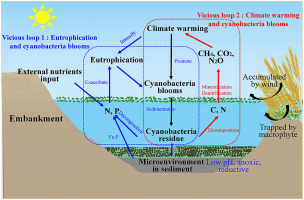当前位置:
X-MOL 学术
›
Water Res.
›
论文详情
Our official English website, www.x-mol.net, welcomes your feedback! (Note: you will need to create a separate account there.)
Climate warming and cyanobacteria blooms: Looks at their relationships from a new perspective
Water Research ( IF 12.8 ) Pub Date : 2017-09-06 , DOI: 10.1016/j.watres.2017.09.008 Xingcheng Yan , Xiaoguang Xu , Mingyue Wang , Guoxiang Wang , Songjun Wu , Zhichun Li , Hao Sun , Ao Shi , Yunhao Yang
Water Research ( IF 12.8 ) Pub Date : 2017-09-06 , DOI: 10.1016/j.watres.2017.09.008 Xingcheng Yan , Xiaoguang Xu , Mingyue Wang , Guoxiang Wang , Songjun Wu , Zhichun Li , Hao Sun , Ao Shi , Yunhao Yang

|
Climate warming and eutrophication are regarded as two important contributors to the occurrence of cyanobacteria blooms in aquatic ecosystems. However, the feedback of cyanobacteria blooms to climate warming and eutrophication is not fully clear. In this study, a microcosm system was established to simulate the decomposition processes of cyanobacteria blooms. It was observed that a large amount of nitrogen and phosphorus was released into the overlying water, and the concentrations of nitrogen and phosphorus were increased with the amount of added cyanobacteria bloom biomass addition. Subsequently, these released nutrients became available for primary production and intensified the eutrophic state of freshwater lakes. During the decomposition of cyanobacteria blooms, the microenvironment acquired low DO, low pH, and reductive conditions. Together with abundant organic matter in the water column and sediment, a large amount of CH4 and CO2 produced through organic matter mineralization, in which CH4 was the dominant fraction, occupied 50%–92% in mass of emitted carbon. Furthermore, a certain amount of N2O, probably underestimated, was produced with a strong greenhouse effect, even though its magnitude was small. These observations clarify that the feedbacks among cyanobacteria blooms formation and climate warming as well as the eutrophication of freshwater lakes are not unidirectional, but bidirectional. Given that climate warming enhanced the occurrence of cyanobacteria blooms, it was proposed that there are two vicious loops between cyanobacteria blooms, lake eutrophication and climate warming, which should be considered in the future management of aquatic ecosystems.
中文翻译:

气候变暖和蓝藻繁殖:从新的角度看它们之间的关系
气候变暖和富营养化被认为是水生生态系统中蓝藻水华发生的两个重要原因。但是,蓝藻繁殖对气候变暖和富营养化的反馈尚不完全清楚。在这项研究中,建立了一个微观系统来模拟蓝细菌水华的分解过程。观察到大量的氮和磷被释放到上覆的水中,并且氮和磷的浓度随着蓝藻水华生物质的添加量而增加。随后,这些释放的养分可用于初级生产并加剧了淡水湖泊的富营养化状态。在蓝藻水华的分解过程中,微环境具有较低的溶解氧,较低的pH值和还原条件。4和有机物矿化产生的CO 2(其中CH 4是主要成分)占排放碳质量的50%–92%。此外,尽管产生的N 2 O量很小,但产生的温室效应却很强。这些观察结果表明,蓝藻水华形成,气候变暖以及淡水湖富营养化之间的反馈不是单向的,而是双向的。考虑到气候变暖增加了蓝藻水华的发生,因此建议在蓝藻水华之间存在两个恶性循环,即湖泊富营养化和气候变暖,这在未来水生生态系统的管理中应予以考虑。
更新日期:2017-09-06
中文翻译:

气候变暖和蓝藻繁殖:从新的角度看它们之间的关系
气候变暖和富营养化被认为是水生生态系统中蓝藻水华发生的两个重要原因。但是,蓝藻繁殖对气候变暖和富营养化的反馈尚不完全清楚。在这项研究中,建立了一个微观系统来模拟蓝细菌水华的分解过程。观察到大量的氮和磷被释放到上覆的水中,并且氮和磷的浓度随着蓝藻水华生物质的添加量而增加。随后,这些释放的养分可用于初级生产并加剧了淡水湖泊的富营养化状态。在蓝藻水华的分解过程中,微环境具有较低的溶解氧,较低的pH值和还原条件。4和有机物矿化产生的CO 2(其中CH 4是主要成分)占排放碳质量的50%–92%。此外,尽管产生的N 2 O量很小,但产生的温室效应却很强。这些观察结果表明,蓝藻水华形成,气候变暖以及淡水湖富营养化之间的反馈不是单向的,而是双向的。考虑到气候变暖增加了蓝藻水华的发生,因此建议在蓝藻水华之间存在两个恶性循环,即湖泊富营养化和气候变暖,这在未来水生生态系统的管理中应予以考虑。


























 京公网安备 11010802027423号
京公网安备 11010802027423号